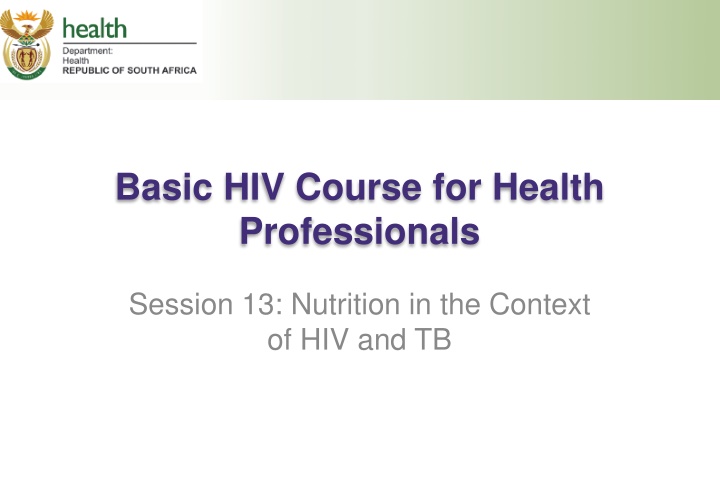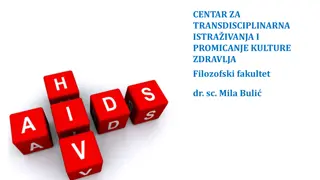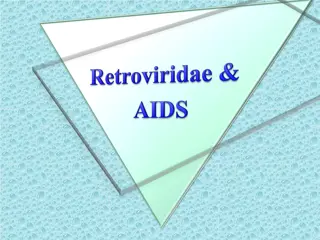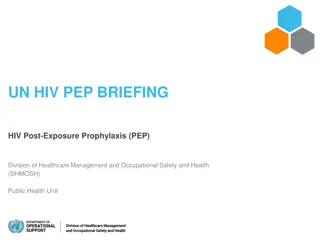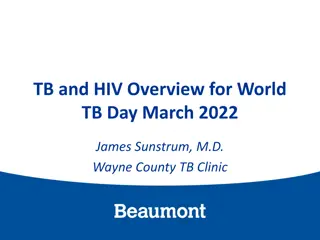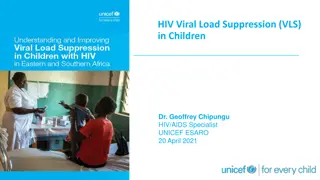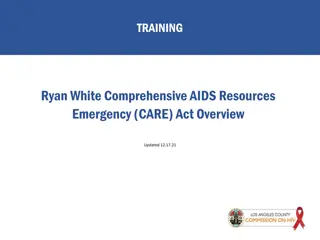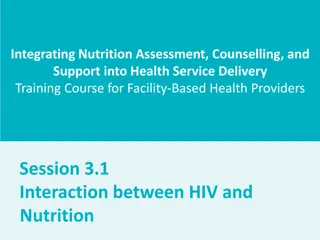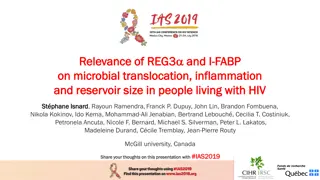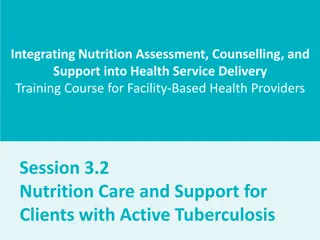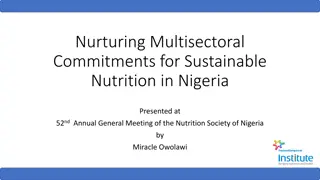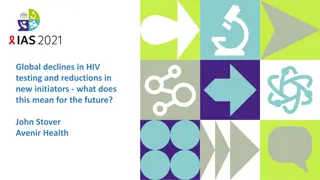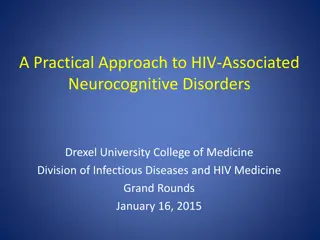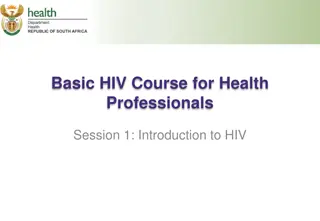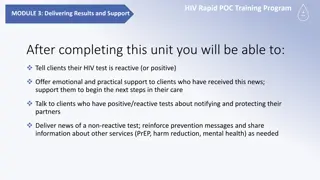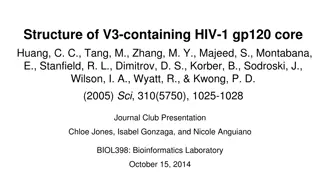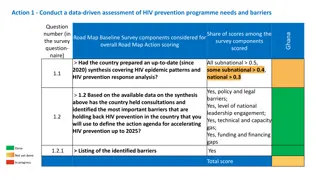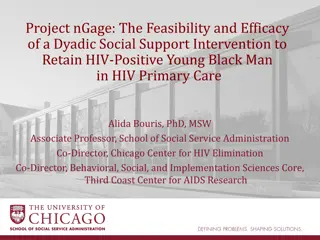Importance of Nutrition in the Context of HIV and TB
Malnutrition is common in people living with HIV and TB, exacerbating immune suppression and disease progression. Good nutrition can strengthen the immune system, improve drug adherence, and manage symptoms, while poor nutrition weakens immunity and increases vulnerability to infections. Consequences of malnutrition include reduced survival, increased morbidity, and socio-economic issues. Understanding the link between HIV, TB, and nutrition is vital in improving health outcomes for affected individuals.
Download Presentation

Please find below an Image/Link to download the presentation.
The content on the website is provided AS IS for your information and personal use only. It may not be sold, licensed, or shared on other websites without obtaining consent from the author.If you encounter any issues during the download, it is possible that the publisher has removed the file from their server.
You are allowed to download the files provided on this website for personal or commercial use, subject to the condition that they are used lawfully. All files are the property of their respective owners.
The content on the website is provided AS IS for your information and personal use only. It may not be sold, licensed, or shared on other websites without obtaining consent from the author.
E N D
Presentation Transcript
Basic HIV Course for Health Professionals Session 13: Nutrition in the Context of HIV and TB
Learning Objectives By the end of this session participants should be able to: Provide the basic concepts of the relationship between food, nutrition and HIV/AIDS Discuss the general dietary needs and practices to reduce morbidity, mortality and progression of HIV to AIDS
The Link between HIV and Nutrition (1) Malnutrition is a common complication of HIV infection Malnutrition further exacerbates the immune-suppression caused by HIV Malnutrition is therefore part of a cycle whereby it both contributes to HIV disease progression and is caused by HIV as indicated in the illustration to the right People are malnourished if: their diet does not provide adequate nutrients for growth and maintenance or they are unable to fully utilize food due to illness (undernutrition) or they consume too many calories (over-nutrition)
Importance of Nutrition Good nutrition can help: people feel strong physically and mentally strengthen the immune system to fight infection people stay productive and physically able prevent undernutrition improve drug adherence and effectiveness manage common symptoms of illness and drug side effects This Photo by Unknown Author is licensed under CC BY-SA
Poor Nutrition Poor nutrition can: Weaken the immune system Increase vulnerability to infections Reduce the body s ability to recover from infections Increase the risk of developing non-communicable diseases This Photo by Unknown Author is licensed under CC BY- NC-ND
What are Some Consequences of Malnutrition in PLHIV and TB Clients? Poor food absorption Poor growth Increased morbidity Metabolic complications Increased risk of OIs Reduced survival Increased cost of treating malnutrition- related illness Increased risk of MTCT of HIV Socioeconomic problems, e.g.: food insecurity poverty
The Vicious Cycle between Undernutrition and HIV and/or TB
Nutrition Assessment and Intervention
Importance of Nutrition Assessment Identifies people at risk of malnutrition for early intervention or referral Detects eating habits that increase disease risk Identifies needs for nutrition education and counselling Identifies local food resources Tracks growth and weight trends Establishes a framework for a Nutrition Care Plan
Nutritional Assessment Patients that are losing weight should be actively investigated and monitored until the cause is found or the weight loss resolves. As a minimum, TB screening and a random blood glucose level should be performed. Further investigations should be done as indicated by history and examination. Refer any patients with documented ongoing weight loss without an obvious cause. Extrapulmonary TB or malignancies may need to be excluded Weight Gain Weight gain at an acceptable rate in a patient who has recently started ART is reassuring and usually indicates immune system recovery However, PLHIV on ART for many years can have a higher risk for hypertension, diabetes and cardiovascular disease. Excessive weight gain should therefore be avoided.
General Guidelines for People Living with HIV and AIDS (1) Get individualised nutrition therapy, see dietitian for further assessment, counselling & nutrition support Get screened for communicable and non- communicable diseases Get weighed regularly and have weight recorded Advise weight loss for overweight and obese patients Regular balanced meals, with good portion control Increased intake of high fibre foods
General Guidelines for People Living with HIV and AIDS (2) Reduce amounts of unhealthy fats, salt, sweets, sugary foods and sugar containing beverages Consider cultural, social and economic issues Include physical activity as part of healthy lifestyle Discourage smoking, alcohol consumption Maintain good hygiene and sanitation Prevent and seek early treatment for infections Seek dietary advice on managing symptoms. Take medicines and food as advised by provider
South African Food Based Dietary Guidelines to Promote a Healthy Lifestyle Refer to pages 183 184 of your participant manual to see a chart with these guidelines
Increased nutritional requirements in PLHIV In the presence of WHO stage 2 conditions or higher, PLHIV should increase their energy intake by 20-30% over the recommended energy intake levels of healthy, non-HIV- infected individuals of the same age, sex, and physical activity levels. Good nutrition is best achieved by consuming a varied diet rich in micronutrients, especially vitamins A, B6, B12, selenium, iron, and zinc. However, a daily multivitamin may provide nutrients in patients who are not able to get a complete or balanced diet, or those who have poor appetite, financial restraints, or other factors that may contribute to malnutrition
Portion Control Tips (1) A meal should consist of: one meat dish option an option of vegetarian for those who are vegetarian one starch option two vegetable options one fruit option and water
Portion Control Tips (2) Size Estimate portion size for. . . starchy foods e.g. rice, samp, cooked pap, pasta whole fruit meat, fish or chicken vegetables cooked beans split peas lentils or nuts all oils, margarines or mayonnaise for peanut butter or hard cheese Fistful = 1 cup Palm of hand 2 open handfuls 1 open handful Tip of thumb = 1 teaspoon
NOTE: Nutrition intervention is usually individualised based on patient requirements, medication, other complications etc. Thus, it is still critical that HIV and T.B clients are referred to a registered dietitian for individualised nutrition assessment and intervention.
Key Learning Points HIV, nutritional status and immune function are linked It is important to identify adults and children that are malnourished and refer them to dieticians for nutritional support People that are infected with HIV have increased nutritional requirements Nutritional advice can be given to people that experience symptoms of HIV or side effects from its treatment
Any Questions? Thank you!
